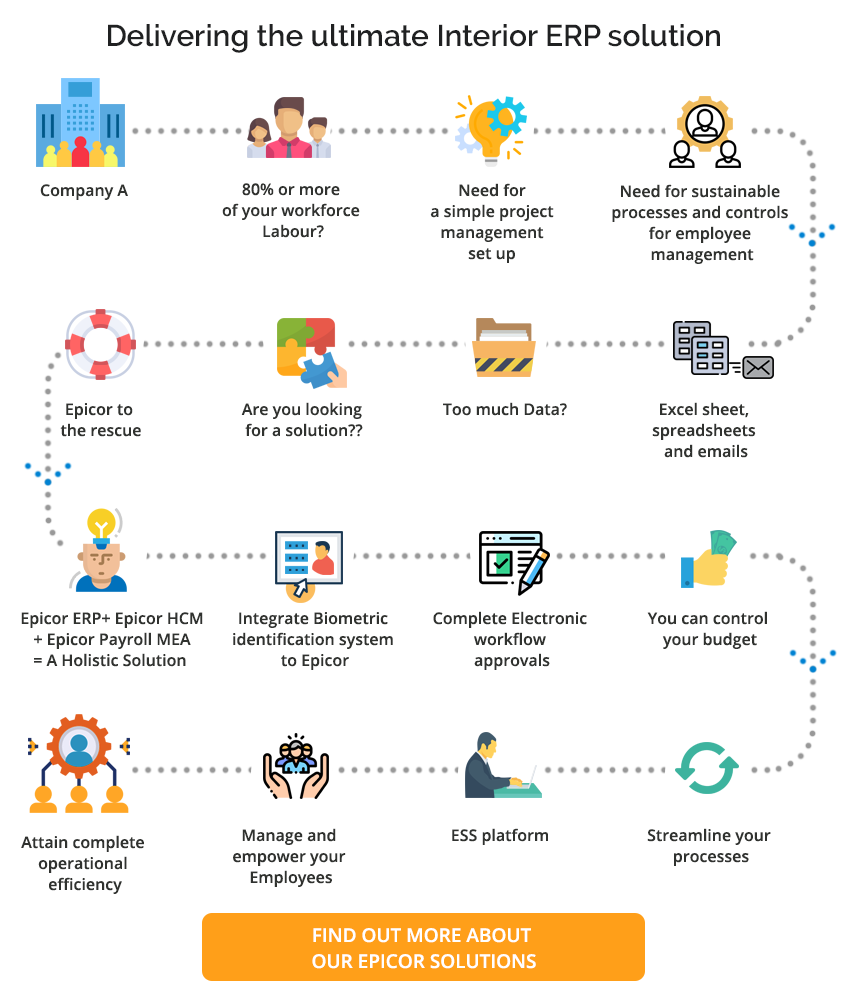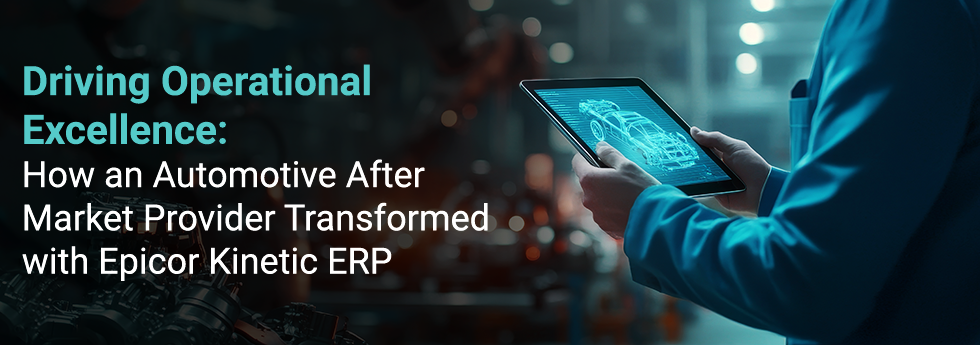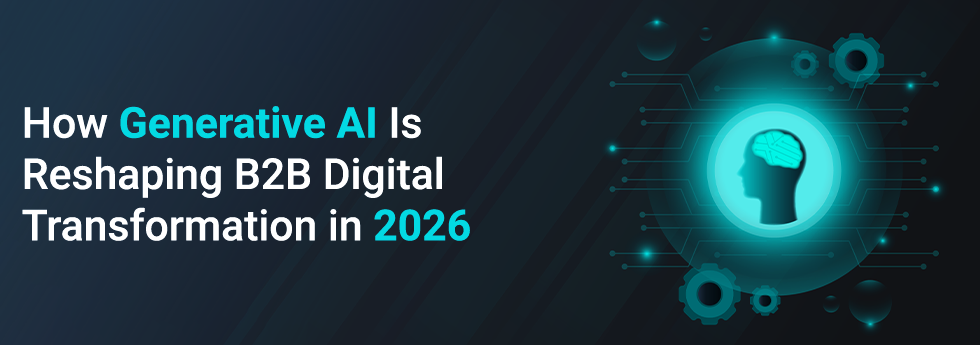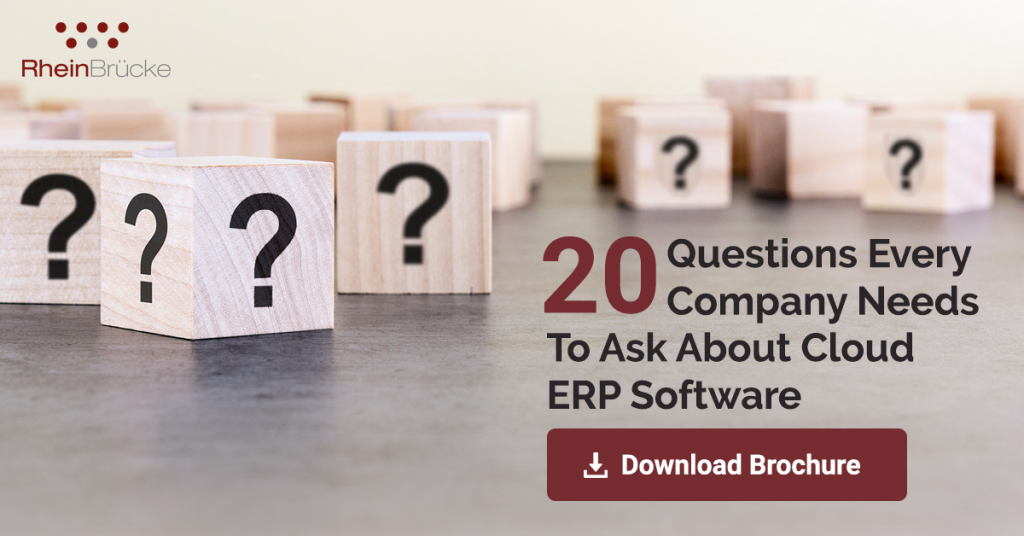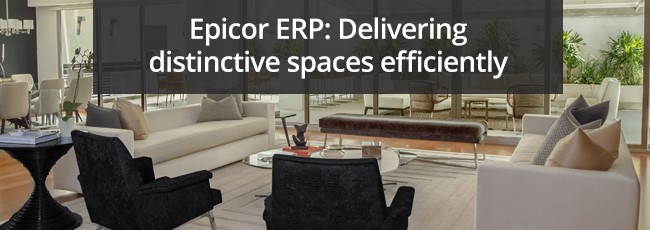

Don’t let the phrase “ERP implementation” scare you. ERP implementations can, but don’t have to be a nightmare as long as you’re sure to stick to a few basic guidelines. Every one of our ERP projects have been different and has had its own challenges. But on completion of a project, the feeling is sublime. To be able to stand back and see all your hard work transform an organization is absolutely thrilling to say the least. Let’s talk about one of the ERP implementation projects we did for one of the largest interior Fit out companies in the Middle East.
When we began the discussion of an ERP implementation there were several inhibitions. The company was not convinced about an ERP being a good fit. They (like many) believed that ERP was unsuitable for SME’s as the cost of ERP implementations are high and larger organisations are able to make up the costs in a shorter timeframe in comparison to smaller firms. Far from the truth. Let me elaborate.
Interested to know More?
Please fill your details to download the case study
It was one of our first projects for an interior fit out company. The work landscape in the Middle East is considerably rigid and the task ahead seemed mammoth. Our customer had used excel sheets and paperwork for a long time. Labour constituted to 80% of the workforce and the company required sustainable processes and controls over employee management, and a simple project management set up.
A simple solution for a complex problem
Our solution was simple. We offered to do an ERP implementation where our Epicor ERP solution would be integrated with our EPICOR HCM solution as well as our EPICOR Payroll MEA solution. Sound complicated? How could it be? We were offering to integrate project management with finance, HR and payroll, ALL on one single system. It was a match made in heaven.
Let me give you a bit of background about the company. There were approximately 40 projects being implemented by the company with more being added to their pipeline. Management found that taking up more business would become difficult because of challenges with control and visibility of ongoing projects. As a project oriented company, they had to revisit their existing enablers so that they could expand operations with increased efficiency.
One of their biggest challenges was minimalistic operational automation. The company used a third party software for procurement and finance for their day to day operations.
Some of the key challenges they faced included difficulties in managing labour requirements across project locations, poor visibility of inventory stocking and details across projects, complex reports to derive insights on actual project costs vs estimated cost, unplanned project cost over runs, a lack of an integrated view for finance and limitations in integrating multiple third party applications.
The Epicor ERP solution enabled the company to maximize productivity across business operations. Implementing modules such as Sales Management, Product Data Management and Costing, Inventory Management, Financial Management, Project Management and Production Planning and Scheduling, the company was able to streamline existing independent systems to work more efficiently from sales order to production floor to project management.
Our Epicor ERP for interior design solution helped project managers’ deal with plans, schedules, resource assignments, budgets and estimates in an integrated way. The project management capabilities of our solution facilitated more efficient data flow and communication, integrated interrelated functions, reduced data duplication, and provided real-time operational visibility. The Epicor ERP 10 solution:
- Enabled electronic workflow approvals to streamline purchasing, document control and contract administration processes.
- Enabled budget control. All the project and items go through a budget control process which ensures that procurement and implementation do not exceed the expected budget.
- Realised improvements in terms of collaboration between various departments, controlling project management aspects such as tracking RFIs and material approvals, streamlining inventory and production processes and well-informed decision making through insightful reports and dashboards.
Human Resources: The department with a personal touch
Another big challenge was managing labour. The labour resided over an hour away from the workshop and was transported to and fro using a daily bus service. However there was no means by which a manager had visibility or accuracy over head count, hours worked, job done etc.
Our solution was to implement a biometric and scanner system that ensured managers would receive data on when employees boarded and exited the bus as well as set up similar systems on the shop floor whereby the employee was required to scan his or her barcode for every job line. This biometric and scanner system was integrated with our Epicor ERP 10 solution so that the data could then integrate into workflows and be used for data analysis. This enabled:
- Labour efficiency: Managers are now able to see the exact head count of employees on a day to day basis as well as determine time spent by each resource on each job. The solution helped remove the manual process of time sheets and provided real time head count and time expense data.
- Project control: Managers now have better control over their projects as they now have visibility over resource allocation and utilization.
- Project Budget control: Managers can now determine if there are too many or too little resources being spent on certain jobs/projects and if resources can be moved to different jobs/projects depending on necessity and budget.
Read now to know more about what is the Importance of HR Payroll?
The Big Bang
Integrating our HCM and Payroll solution with Epicor 10 was imperative as the company required a solution to improve payroll efficiency and manage employees across processes and projects. Our main objective was to simplify the HR process. As mentioned earlier, 80% of the workforce was labour and managing labour efficiently was a big challenge.
Our payroll solution was linked to the biometric scanner solution so that information from the system could be used to calculate leave, holidays, time taken on jobs, overtime etc. This information is then used to calculate pay. Prior to the implementation of our solution, payroll was calculated on the 10th of every month and is now being processed and paid on the 2nd of every month. The solution also helped reduce the resources required in finance from 10 personnel to 5.
Managing the managers of projects is also a complex task, as visibility on the what, how and when of managers was opaque. Our solution offered an online web portal for managers that not only gave them online visibility of all projects under them but also provided reports and dashboards on the timeline of projects, milestones reached etc. Managers were also required to enter a time breakdown across all projects which was also linked to payroll. This way the management team also got visibility and clarity over projects and could make decisions on which projects required more time and effort from managers and so on and so forth.
As part of our payroll system, we also offered employees an Employee Self Service portal to empower employees and provide them with complete visibility over all HR processes. In the Middle East it is common for employers to hold onto the passport of employees during the duration of their work. The ESS portal enabled a simple process workflow for any employee request. The workflow comprised of 4 steps, request, approve, deliver and close.
Let’s take an example. If an employee required his/her passport to travel overseas, he/said could log into the ESS portal and create a request for his passport. This task would then be sent to the required managers for approvals (This is a pre-set workflow as the approvers for this task are already pre-mapped). The task is then moved to ‘delivered’ after the passport has been delivered to the said employee and then closed. This simple workflow can also be used by the employee for any requests such as request for a personal letter of recommendation, a letter for the bank, request for a loan, and request for a work certificate during the exit process etc.
The integration of the HCM and payroll solution assisted the human resource department during the recruitment process as the solution enabled workflows for recruitment processes and approvals and the ESS solution ensured that employees uploaded documentation etc. that was required for that particular role/responsibility.
The key highlights of our solution were as follows:
- Structured implementation, compliant with statutory requirements
- All Third-party managed operations have complete visibility via an integrated view of estimation, procurement and project execution through ERP
- Material request validation with specification and cost
- Integrated Time and Attendance for Payroll and Project costing
- Automation of Material codification with 8 different attributes
- Budget definition based on estimates and variance analysis
- Consolidated planning for all departments from Design (Engineering) to execution.
The End
The company improved their operational efficiency significantly with our Epicor solution. More importantly, Epicor ERP implementation facilitates the company’s primary goal of implementing balance scorecard across the enterprise.
Some of the transformational accomplishments included a shift from handwritten and spread sheet managed projects to integrated project management process facilitated by Epicor ERP for Interior design in Middle East. The cumbersome invoicing processes were automated, driving significant DSO reductions. From the accounting side of things Epicor enforced budget controls which did not exist earlier. EPICOR Social Enterprise across users eliminated traditional methods of collaboration and alerts using emails, reports etc.
Interested to know More?
Please fill your details to download the case study
Our HCM and Payroll solutions brought best practice approaches to managing human resources and the biometric integration was not only used for attendance but also project time keeping and labour transactions resulting in accurate labour cost reporting.
All in all, it’s safe to say that this is one of our best stories yet. At RheinBrücke we believe in sharing our stories so those requiring the same or similar solutions can have a read and reach out to us for advice. We love a good challenge.
Click here to know more about our ERP solution for Interior Design.

